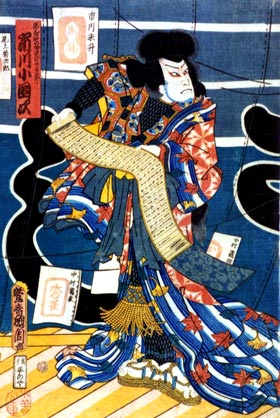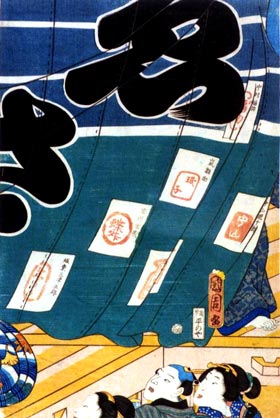| MIYAJIMA NO DANMARI |
| Play title | Miyajima no Danmari |
| Author | Kawatake Shinshichi II |
| History |
The dance "Miyajima no Danmari" was staged for the first time under the title "Chiyo Banzei Araki no Shimadai" in the 9th lunar month of 1842 at the Ichimuraza, starring Nakamura Utaemon IV. It was revived in 1862 by the playwright Kawatake Shinshichi II and staged in August at the Moritaza, starring Ichikawa Kodanji IV in the leading roles of the courtesan Ukifune and the thief Kesatarô. "The main character of the infamous thief, Kesatarô, (disguised as the courtesan Ukifune), was not established until 1862, when it was played by one of the greatest actors of the Bakumatsu period, Ichikawa Kodanji IV. Even today, when one looks at Ukiyo-e woodblock prints of Kodaji's performance, one can feel the thrill of his stage presence and the mysterious atmosphere of grand historical drama nixed with the sinister underworld of criminals and evil sorcerors. A danmari is a play or scene without dialogue. It is often associated with kaomise performances because it affords a perfect opportunity to introduce all the major actors of a troupe to the audience. Danmari were originally performed within the context of a long play and usually featured characters from that play, but today many of the most famous danmari have become short, independent pieces. The typical, jidai danmari, (a danmari from an historical drama), is highly stylised, and features the kind of musical accompaniment called Ôzatsuma. This is a special declamatory style of narration performed to robust and powerful shamisen accompaniment. It is well suited to the masculine and exaggerated acting style known as aragoto, or else to passages of great grandeur in historical plays. Ôzatsuma was once an independent musical school, but today is performed by musicians of the Nagauta style. A danmari is often set at night in the mountains, where a group of different characters accidentally come together in search of a missing treasure or flag. as they grope about in the darkness the object of their search will pass from one to the other until at last, one character will make off with it, leaving all the others to pose grandly as the curtain is drawn. The character in possession of the treasure will thus be left alone on the hanamichi pathway, where he or she will then make a stylised exit called roppô. Literally meaning "six directions", the term roppô refers to the violent swinging of the arms and legs as the actor makes his way to the back of the auditorium." Courtesy of Paul M. Griffith (1997) |
| Key words |
Danmari Genji Heike Hippari no mie Itsukushima Jinja Keisei Ôzatsuma Roppô Suppon Taira Kiyomori |
| Summary |
"Miyajima no Danmari" is somewhat unusual in that, rather than being set in the mountains, the action takes place at the Itsukushima Shrine by the sea. This provides a very beautiful backdrop which is given life by the lyrics of the Ôzatsuma accompaniment. This describes how the lights from the shrine's lanterns reflect in the water, how a hazy moon shines down upon the sand, washed by the salt tide, and how the murmur of lapping waves is heard softly in the background. After this, the performance is all down hill! Three characters rise into view on the central stage-lift: in the centre and holding a letter-scroll is the top-ranking courtesan, Ukifune, and on either side of her are two young men, Shigetada and Kawatsu Saburô. Shigetada, a warrior of the Genji clan, has come to investigate reports of thefts and strange happenings in the area, and he is particularly surprised by the presence of acourtesan. An important scroll has gone missing and he suspects that Ukifune has stolen it, but when he questions her about the scroll in her possession she insists it is a love letter. Suddenly we are to imagine that the lanterns' lights are blown out by a sea breeze and all is plunged into darkness. Here begins the danmari itself for several characters appear, mostly in disguise, and all grope about for the scroll. Danmari are usually regarded as great tests of the actors' abilities because they must project their presence to the audience without words. Yet more characters appear who are not all explained in text, but who include the leader of the Heike clan, lord Kiyomori. Ukifune reveals her occult powers by vanishing into a large stone lantern, after which all the other characters form a long chain on stage. This is also very characteristic of danmari scenes and is known as jakago, "snake basket", a term that likens their long shape to that of a serpent. Such stylised movements are among the highlights of these danmari and are appreciated for their formal beauty and imposing atmospere. Eventually, Ukifune reappears, though now her form has changed into that of a man. His true identity is the notorious thief, Kesatarô, who has the power to transform his appearance. At last, the precious scroll is unravelled: it is the red flag of the Heike clan, an important symbol of authority, and all the main actors grab hold of it. After another silent struggle, Kesatarô manages to retrieve the flag and again disappears down a smaller stage-left, leaving the rest of the cast to perform the final grand pose as the curtain is drawn. This final pose is an hippari no mie, "pulling-apart pose", so named because all the main characters seem to be pulling away from each other, with Kiyomori standing on a red platform in the centre. The play is not yet over. We now reach one Kabuki's great moments as the thief, Kesatarô, reappears mysteriously on the hanamichi suppon, a stage-lift usually reserved for ghosts and occult beings. Kesatarô is in the middle of transforming back into the female Ukifune and so the upper half is still that of a man while the bottom half is now a woman. From his waist down are the three layers of brocade kimono worn by courtesans and in his hair have appeared fabulous tortoise-shell hairpins. He carries the treasured flag with him. It is now that the actor makes his unique exit. Though it is normal in danmari for the actor to execute a roppô, this is the only instance of a semi-finale roppô and it is known as the keisei, "courtesan roppô". The actor must portray both the female Ukifune, and the male Kesatarô as he exits, and he should make the characterisations clear to the audience as does so. Ukifune will walk in the distictive hachimonji, "figure-eight" style that was adopted by courtesans as they paraded through the streets of the pleasure quarters, while Kesatarô will perform magnificent mie poses, crossing one eye in typical male-role fashion. Courtesy of Paul M. Griffith (1997) |
 |
 |
|
Ichikawa Kodanji IV playing the role of Kesatarô in the drama "Miyajima no Danmari", which was staged in the 8th lunar month of 1862 at the Moritaza (print made by Kunichika) |
|
|
|
| Contact | Main | Top | Updates | Actors | Plays | Playwrights | Programs | Links | FAQ | Glossary | Chronology | Illustrations | Prints | Characters | Derivatives | Theaters | Coming soon | News |